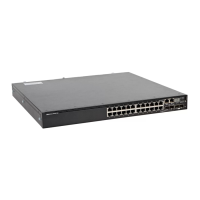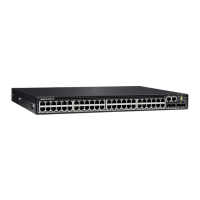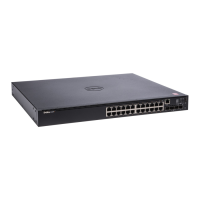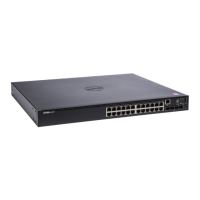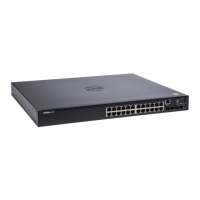Configuring Class-of-Service 1315
How Are Traffic Queues Defined?
For each queue, you can specify:
• Minimum bandwidth guarantee—A percentage of the port’s maximum
negotiated bandwidth reserved for the queue. Unreserved bandwidth can
be utilized by lower-priority queues. If the sum of the minimum
bandwidth is 100%, then there is no unreserved bandwidth and no sharing
of bandwidth is possible.
• Scheduler type—strict/weighted:
– Strict priority scheduling gives an absolute priority based on CoS
queue number, with traffic in the highest numbered queue sent first,
then the next lowest numbered queue, and so on. Weighted queues
are serviced after all strict priority queues have been serviced.
– Weighted scheduling selects packets for transmission with a fixed
weighting equal to the CoS queue number plus one. The weighted
scheduler measures bandwidth based upon bytes vs. packet counts,
offering a better granularity of scheduling. For example, if CoS queues
0, 1, and 2 have an equal offered load toward a congested output port,
CoS queue 2 will receive 3/6 of the bandwidth, CoS queue 1 will
receive 2/6 of the bandwidth, and CoS queue 0 will receive 1/6 of the
bandwidth.
The minimum bandwidth setting can be used to override the strict priority
and weighted settings. The highest numbered strict priority queue will
receive no more bandwidth than 100 percent minus the sum of the minimum
bandwidths percentages assigned to the other queues. If used, it is
recommended that minimum bandwidth percentages only be high enough to
ensure a minimum level of service for any queue; i.e., the sum of the
minimum bandwidth percentages is a small fraction of 100%. This ensures
that the system can respond to bursts in traffic. Setting the minimum
bandwidth percentages such that they sum to 100% effectively sets the
scheduler such that sharing of bandwidth is disabled.
Which Queue Management Methods Are Supported?
The switch supports the following methods, configurable per-interface-
queue, for determining which packets are dropped when the queue is full:
• Taildrop—Any packet forwarded to a full queue is dropped regardless of its
priority.

